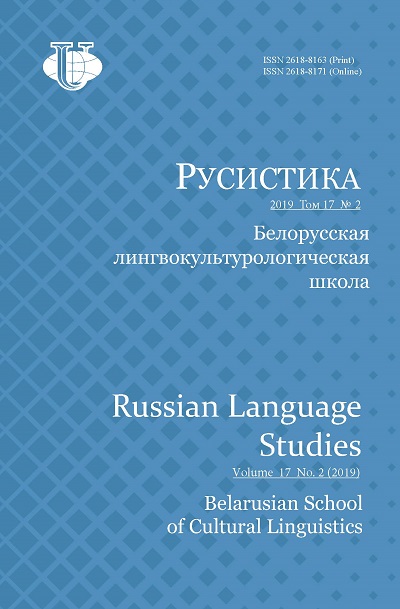Поликультурная идентичность в контексте городского пейзажа
- Авторы: Поплавская Т.В.1
-
Учреждения:
- Минский государственный лингвистический университет
- Выпуск: Том 17, № 2 (2019): Белорусская лингвокультурологическая школа
- Страницы: 213-228
- Раздел: Лингвокультурология: теоретические и прикладные аспекты
- URL: https://journals.rudn.ru/russian-language-studies/article/view/21116
- DOI: https://doi.org/10.22363/2618-8163-2019-17-2-213-228
- ID: 21116
Цитировать
Полный текст
Аннотация
Цель статьи состоит в выявлении и описании структуры городских вывесок, содержащих переключение кодов, иноязычную или псевдоиноязычную информацию. Эта тема представляется актуальной, поскольку современные города с русскоязычным населением наводнены надписями, вводящими в заблуждение относительно инокультурных реалий и выполненными с грамматическими и лексическими ошибками. В ходе исследования были проанализированы наименования учреждений питания, салонов красоты, предприятий автосервиса и адвокатских контор, зафиксированные на вывесках соответствующих организаций и представленные на всеобщее обозрение. Установлена специфика обозначений предприятий сервиса различного рода и ее соответствие/несоответствие миссии организации. Анализ вывески как вербального фрагмента городского пейзажа подводит к выводу о необходимости введения нового термина - псевдополикультурная идентичность. Феномен псевдополикультурной идентичности характеризует коммуникативное пространство большого города и может быть отнесен к деструктивным явлениям, формируемым в лжеинокультурной среде, где авторы иноязычных наименований пренебрегают как структурой, так и значением предлагаемых обозначений, а целевая аудитория формирует неадекватные языковые стереотипы.
Об авторах
Татьяна Викторовна Поплавская
Минский государственный лингвистический университет
Автор, ответственный за переписку.
Email: taniapoplavskaia@gmail.com
доктор филологических наук, профессор, заведующая кафедрой речеведения и теории коммуникации Минского государственного лингвистического университета, член ВАК РБ, руководитель исследовательской группы «Языковая ситуация в Беларуси: межкультурный аспект» (Минск, Республика Беларусь). Сфера научных интересов: коммуникативное пространство, коммуникативные стратегии, организационная коммуникация, межкультурная коммуникация
Республика Беларусь, 220034, Минск, ул. Захарова, 21Список литературы
- Арутюнова Н.Д. Язык и мир человека. М.: Языки русской культуры, 1999. 895 с.
- Белова К.А. Интернет-дискурс Беларуси в социолингвистическом аспекте: дис. … канд. филол. наук. Минск, 2014. 173 c.
- Боас Ф. Методы этнологии // Антология исследований культуры. Т. 1. СПб.: Университетская книга, 1997. 728 c.
- Дроненко Д.М. Национально-культурная идентичность как социально-философская проблема: дис. … канд. филос. наук. Волгоград, 2003. 163 с.
- Красных В.В. Этнопсихолингвистика и лингвокультурология: курс лекций. М.: Гнозис, 2002. 284 с.
- Маслова В.А. Введение в лингвокультурологию. М., 1997. 206 с.
- Маслова В.А. Лингвокультурология: учебное пособие для студентов высших учебных заведений. М.: Академия, 2001. 208 с.
- Потебня А.А. Символ и миф в народной культуре. М.: Лабиринт, 2000. 184 с.
- Прохоров Ю.Е. Дискуссионный монолог о диалоге культур // Диалог культур. Культуры диалога: человек и новые социогуманитарные ценности. М.: Форум; Неолит, 2017. 424 с.
- Психология межличностных коммуникаций / сост. П. Вацлавик, Дж. Бивин, Д. Джексон. СПб.: Речь, 2000. 310 с.
- Степанов Ю.С. Концепты. Тонкая пленка цивилизации. М.: Языки славянских культур, 2007. 248 с.
- Телия В.Н. Русская фразеология: семантический, прагматический и лингвокультурологический аспекты. М.: Языки русской культуры, 1996. 284 с.
- Benwell B.M. Constructing discussion tasks in university tutorials: shifting dynamics and identities // Discourse Studies. 2002. Vol. 4. Iss. 4. Pp. 429-453.
- Derrida J. Of grammatology. MD; Baltimore: Johns Hopkins University Press, 1976.
- Foucault M. Archaeology of knowledge. New York: Pantheon, 2002. 245 p.
- Gergen K.J. Technology and the self: from the essential to the sublime // Constructing the self in a mediated world / Еds. D. Grodin, T.R. Lindlof. London: Sage, 1996.
- Habermas J. The theory of communicative action. In 2 vols. Vol. 2. London: Heinemann, 1987.
- Hall S. Who needs identity? // Identity: a reader / Еds. P. du Gay, J. Evans, P. Redman. London: Sage, 2000. Рp. 15-31.
- Hymes D.H. An ethnographic perspective // New Literary History. 1973. Vol. 5. No. 1. Pp. 187-201. The Johns Hopkins University Press.
- Saville-Troike M. The ethnography of communication: an introduction. University Park Press, 1982. 290 p.
- Taylor C. Sources of the self: the making of modern identity. MA; Cambridge: Harvard University Press, 1989.
Дополнительные файлы














